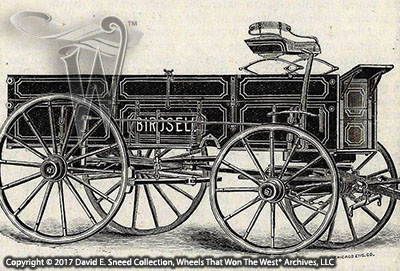To my wife’s chagrin, our collection ofcentury-plus-old vehicles now numbers in the dozens. It’s a tally that’s been fairly fluid overthe years. As with any seriouscollecting effort, the ebb and flow of buying, trading, and acquiring differentpieces has gradually grown the group into a unique set of qualitysurvivors. One of the wagons I picked upeons ago is a Birdsell with a boot-end box. I’ve hung onto this one due to its completeness and overallcondition. It’s a heavy rascal, as wefound out when we first pulled it out of a barn in Ohio. It’s still in its ‘as-found’ condition.
Based on a number of design features onthe box and running gear, the wagon was most likely built around or just priorto the turn-of-the-twentieth-century. Itwas made in South Bend, Indiana. Similarto Detroit’s connection to several major automobile companies, the city ofSouth Bend was once home to a number of notable wagon manufacturers. In fact, major brands like Winkler,Coquillard, South Bend, and Studebaker all called this city in north-central Indiana ‘home.’
 |
| Likemost wagon makers with extended histories, the look of Birdsell design features, logos, and paint styles evolved over theyears. |
John Comly Birdsell started his company inthe mid-1800’s and for years was known as a manufacturer of cloverhullers. Near the end of the Civil War,Birdsell moved his factory from Monroe County, New York to South Bend toimprove the firm’s access to quality timber, skilled labor, and railroadfacilities. He added farm wagons to his product offerings in 1887 and theyquickly gained national acclaim. Reinforcing their popular reputation, Birdsell claimed that every pieceof wood was air-dried from 3-5 years. Early promotional literature also pointed out that the wagons were“carefully painted by hand (not dipped).”
 |
| TheBirdsell Mfg Company built a number of different types of vehiclesincluding farm, spring, express, and delivery wagons as well as carriages andbuggies. |
Like a few other large-scalemanufacturers, Birdsell had its own foundry to produce its skeins (rhymes withtrains). Skeins are the metal thimbleson the end of the axle on which the wheel hub rests and rolls. Some of the earliest skein sizes thatBirdsell offered included 2 3/4 x 8 ½, 3 x 9, 3 ¼ x 10, and 3 ½ x 11. The first (and smaller) number in thesemeasurements is a reference to the size opening where the wooden axle enters the hollow 'bell' of the skein. The second number highlightsthe length of the skein’s running surface. Collectively, the numbers point to wagon sizes, hauling capacities, and,by default, the type of work a particular vehicle might be limited to.
From the start, the company built bothnarrow and wide track wagon gears. Thesevariations not only served different load capacities but were developed for thespecific needs of farmers, ranchers, and freight haulers in different parts ofthe country. Initial wheel heightsmeasured 44 inches in the front and either 52 or 54 inches in the rear. Boxes were sold in 38 and 42-inch widths.
 |
| Birdsellis one of several notable builders that offered a spring seat very similar inappearance to those used by the Peter Schuttler brand. |
According to the first wagon brochurespublished by Birdsell, their inaugural axles incorporated a ‘new’ design style. Instead of the wooden axles having a roundedshape to the top and bottom, as was often the case in the 1880’s and earlier,the bottom was left squared off so more wood remained for greater support. Makeup of a Birdsell running gear was createdfrom several different types of wood stock. While the doubletree, singletree, neck yoke, and axles were generallymade from hickory, many other parts of the gear as well as the spokes, andfelloes were often fashioned from white oak. Hubs were made from black birch or white oak. Elsewhere in their construction designs,boxes were made of poplar and box bottoms employed yellow pine.
In addition to clover and alfalfa hullersas well as two-horse farm wagons in multiple variations, the Birdsell productline included log wagons, dump carts, one-horse wagons, lumber gears, oil pipegears, and spring wagons. In theirearlier years of vehicle manufacture, they also made buggies, carriages, and phaetons along with express and delivery wagons. While the Birdsell facility was considerably smaller than its mega-competitor and city neighbor, Studebaker, the business dwarfed most wood vehicle makers. Reinforcing that point, Birdsell's factory occupied 21 acres of floor space with aproduction capacity of 18,000 wagons per year. Similarly, their wagons and running gears were distributed throughout the UnitedStates and were consistently touted for their strength, durability, lightdraft, and quality finish.
 |
| Thisimage shows a variety of early promotional material distributed by theBirdsell Manufacturing Company. |
Like most other wagon brands, Birdselltransitioned from a widely traveled transportation icon to a more sedentary andutilitarian piece of farm equipment by the 1920’s. By the early 1930’s, factory repair parts forthese wagons were only available through Kentucky Manufacturing Company with noparts serviced for the brand by the mid-1940s.
From research to recovery, whether we’relooking at a national name like Birdsell or a lesser-known local brand, it’simportant to understand the history of particular piece – where and how it wasused, the distinctions of its design, unique accessories, timeframe of manufacture,and more. All of these elements help usbetter appreciate a set of wheels while also preserving and perpetuatinghistory.
See ya next week!
Please Note: As with each of our blog writings, all imagery and text is copyrighted with All Rights Reserved. The material may not be broadcast, published, rewritten, or redistributed without prior written permission from David E. Sneed, Wheels That Won The West® Archives, LLC
Please Note: As with each of our blog writings, all imagery and text is copyrighted with All Rights Reserved. The material may not be broadcast, published, rewritten, or redistributed without prior written permission from David E. Sneed, Wheels That Won The West® Archives, LLC